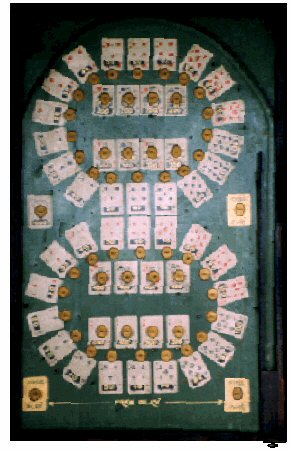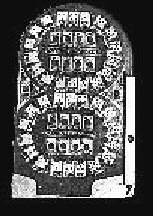
This tabletop Bagatelle game was donated to the Museum in 1980. It was manufactured by the Lindstrom Tool and Toy Company, Bridgeport, Conn., in the United States in the 1930s.
The Museum's version is made of wood, printed paper, tin, and has nails as marble deflectors in various places on the board's surface. The entire board is in a dark wood frame and covered by clear glass. A target hole is cut into the board in front of each card. The intent of the game is to achieve a winning "5 Card Stud Poker Hand" by having each of 5 marbles land in a target hole on the board's surface.
It was not unusal for a manufacturer to issue modified versions of the same game at different times just by altering the printed image on the top of the board.

A somewhat different version - pictured on the right - is called Play Boy and is illustrated in: B.C.Natikin & S. Kirk, All About Pinball, New York: Gosset & Dunlap, 1977, p. 20. However, a comparison of the Museum's version with "Play Boy" indicates a number of differences. There are additions at the bottom of "Play Boy", and this board is not enclosed in a frame.
For proper play, the top of the board should be raised upon a support on the table so that the bottom of the board sits on the table and the entire board slants downward toward the player. Like most standard tabletop Bagatelle games, this game was designed for a right-handed player. On the right side of the board is a Runway - a covered metal channel with an open hole half way up its length in which to place a marble. The function of the Runway is to direct the marble to the top surface of the board. When a marble is placed in the Runway hole and the board is properly slanted, the marble rolls down the Runway and rests against a Plunger - a spring-loaded cylindrical rod which when operated by the player, propels the marble up the Runway.
When a player pulls the Plunger and releases it, the Plunger cylinder hits the marble, propels it up the Runway, and then gravity takes over and the marble rolls down the slated board surface. The degree of propulsive force upon the marble is dependent upon how far out a player extents the Plunger from the board and how quickly the Plunger is released. Different degrees of force cause the marble (during its decent on the board surface) to rebound against the sides of the board and against the embedded nails which act as deflectors. As the marble rebounds against the nails, it either falls into a target hole (resulting in a player"being dealt a specific card"), or comes to rest at the bottom of the board without resulting in a card for that "shot".
Last update February 25, 2010